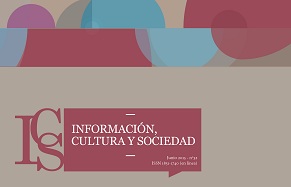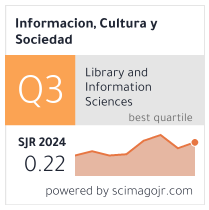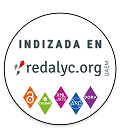The spaces offered as a library service: The cases of the university libraries of Madrid and Catalonia
Abstract
The purpose of this work is to check if the libraries of the universities of Madrid and Catalonia offer the use of some of their spaces as a library service. The information of the websites of the libraries is studied and a questionnaire is sent to the libraries that do not have this information. The analyzed aspects are: quantity and variety of spaces, use or not use of the websites to promote the offer of this type of services, location of this information on the websites and content provided. Among the results of the analysis of the 30 universities studied, it has been proven, for example, that 23 universities offer some of their library spaces as a service, of which 20 indicate it on the websites of the libraries; that the variety of spaces offered includes 26 different types, highlighting for their greater presence the space available for group work (21 universities), individual and / or silence work spaces (12 universities) or computer spaces (10 universities), etc.Downloads
References
Aguilera Giménez, Mario. 2017. 2021: una odisea del espacio bibliotecario. En Congreso Nacional de Bibliotecas Públicas: espacio físico y virtual (8º: 2017: Madrid). Madrid: Ministerio de Educación, Cultura y Deporte, Subdirección General de Documentación y Publicaciones, p. 44-52. http://www.mecd.gob.es/congresobp/portada/2016/presentacion.html. [Consulta: 13 mayo 2019].
Alarcón Orozco, Carmen; Elena Gómez Lozano y María Luz Blanco Luego. 2016. Adaptando espacios, conectando gente: la experiencia realizada en la Biblioteca General del Campus de Cuenca. En RUIDERAe: Revista de Unidades de Información. No. 10 (2º semestre 2016). <https://revista.uclm.es/index.php/ruiderae/article/view/1298>. [Consulta: 2 junio 2019].
Alonso-Arévalo, Julio. 2018. Makerspaces y bibliotecas. Barcelona: Editorial UOC.
Alonso-Arévalo, Julio. 2019. Makerspaces: las bibliotecas universitarias como espacio de creatividad e Innovación. En Foro Internacional Sobre Evaluación de la Calidad de la Educación Superior y de la Investigación (FECIES). Monasterio de San Martín Pinario, Santiago de Compostela (16º: 29-31 mayo 2019: Santiago de Compostela) <https://universoabierto.org/2019/05/29/makerspaces-las-bibliotecas-universitarias-como-espacio-de-creatividad-e-innovacion/>. [Consulta: 18 junio 2019].
Andrews, Camille; Sara E. Wright y Howard Raskin. 2016. Library learning spaces: Investigating libraries and investing in student feedback. En Journal of Library Administration. Vol. 56, no. 6, 647-672. <https://doi.org/10.1080/01930826.2015.1105556>
Anexo: Universidades de España. 2019. Wikipedia. <https://es.wikipedia.org/wiki/Anexo:Universidades_de_Espa%C3%B1a>. [Consulta: 08 junio 2019].
Anglada, Lluís. 2012. Bibliotecas universitarias: cabalgando la tecnología, siguiendo al usuario. En El profesional de la información. Vol. 21, no. 6 (noviembre-diciembre), 553-556. <http://dx.doi.org/10.3145/epi.2012.nov.01>
Boosinger, Marcia; Bonnie MacEwan; Denise Baker; Ashley Goerke; Adelia Grabowsky; Cory Latham; Kasia Leousis; Christopher Mixon; Catherine Price; Juliet Rumble; Greg Schmidt; Cayce VanHorn; Danielle Cooper; Lise Mckean y Nancy Fried Foster. 2016. Reconfiguring Auburn University’s main library for engaged active student learning. En Ithaka S+R. Research Report. <https://doi.org/10.18665/sr.284239>
Brown, Sherri; Charlie Bennett; Bruce Henson y Alison Valk. 2014. SPEC Kit 342 – Next-Gen Learning Spaces. Washington, DC: Association of Research Libraries.
Burn, Katie; Matthew S. Cunningham; Liz Waller; Emma Walton y Graham Walton. 2016. Capturing the student user experience (UX) in York and Loughborough University Library Buildings. En Performance Measurement and Metrics. Vol. 17, no. 2, 175-187. <https://goo.gl/rxxGcC>. [Consulta: 17 mayo 2019].
Caridad Sebastián, Mercedes; Fátima García López; Sara Martínez Cardama y Ana María Morales García. 2018. Bibliotecas y empoderamiento: servicios innovadores en un entorno de crisis. En Revista Española de Documentación Científica. Vol. 41, no. 2, e206. <https://doi.org/10.3989/redc.2018.2.1486>
Cascajares Rupérez, Milagros; Encarnación Fuentes Melero y José Juan Moreno Martínez. 2004. Nuevos espacios para el aprendizaje y la investigación de la Biblioteca de la Universidad de Almería. En Boletín de la ANABAD. Vol. 54, no. 1-2, 281-294. <https://www.anabad.org/2004-num-1-2-enero-junio-boletin-de-anabad/> [Consulta: 17 mayo 2019].
Choy, Fatt Cheong y Su Nee Goh. 2016. A framework for planning academic library spaces. En Library Management. Vol. 37, no. 1-2, 13-28. <https://doi.org/10.1108/LM-01-2016-0001>
Cocciolo, Anthony. 2010. Alleviating physical space constraints using virtual space?: A study from an urban academic library. En Library Hi Tech. Vol. 28, no. 4, 523-535. <http://dx.doi.org/10.1108/07378831011096204>
CRUE, REBIUN. 2011. III Plan estratégico de Rebiun 2020 <https://www.rebiun.org/sites/default/files/2017-11/Plan%20Estrat%C3%A9gico%20REBIUN.pdf>. [Consulta: 3 mayo 2019].
Davis, Ann Marie Lynn. 2018. Current Trends and Goals in the Development of Makerspaces at New England College and Research Libraries. En Information Technology and Libraries. Vol. 37, no. 2, 94-117. <https://doi.org/10.6017/ital.v37i2.9825>
Directorio bibliotecas españolas. 2019. Gobierno de España. Ministerio de Cultura y Deporte <http://directoriobibliotecas.mcu.es/dimbe.cmd?apartado=portada>. [Consulta: 1 abril 2019].
Environmental Scan. 2019. Chicago: ACRL Research Planning and Review Committee.
Gallo-León, José Pablo. 2015. La biblioteca es servicio (y en ello está nuestro futuro). En El profesional de la información. Vol. 24, no. 2, 87-93. <http://dx.doi.org/10.3145/epi.2015.mar.01>
Gallo-León, José Pablo. 2016. Los edificios para una nueva época de las bibliotecas: en el 2029 aún tendremos paredes. En Bibliotecas 2029: Documentos de las Jornadas “Bibliotecas 2029”. Murcia: ANABAD. p. 33-41. <http://eprints.rclis.org/29094/>. [Consulta: 7 mayo 2019].
Garmer, Ami K. 2014. People, Place and Platform: The role of the 21st-century library in the digital era is built on its three key assets: people, place and platform. En Rising to the challlenge. Re-Envisoning Public Libraries: A report of the Aspen Institute Dialogue on Public Libraries. Washington, D.C: The Aspen Institute, p. 10-20 <http://csreports.aspeninstitute.org/documents/Aspen-LibrariesReport-2017-FINAL.pdf>. [Consulta: 11 abril 2019]
González-Fernández-Villavicencio, Nieves. 2017. Espacios físicos de la biblioteca universitaria en el nuevo ecosistema de aprendizaje. En Anuario ThinkEPI. Vol. 11, 109-118. <https://doi.org/10.3145/thinkepi.2017.14>.
González Martínez, Larisa. 2013. Learning Commons en bibliotecas académicas. En Biblios. Revista electrónica de bibliotecología, archivología y museología. No. 53, 88-96. <http://dialnet.unirioja.es/descarga/articulo/4919646.pdf>. [Consulta: 25 mayo 2019]. < https://doi.org/10.5195/biblios.2013.136>.
Haapanen, Mia; Pirkko Kultamaa; Tuulevi Ovaska y Kirsi Salmi. 2015. Reducing library space can promote the shift from storage of print-collections towards a learning-centre without limiting the access to information. En Library Management. Vol. 36, no. 8-9. <https://doi.org/10.1108/LM-06-2015-0051>
Head, A. 2016. Planning and Designing Academic Library Learning Spaces: Expert Perspectives of Architects, Librarians, and Library Consultants (December 6). <http://dx.doi.org/10.2139/ssrn.2885471>
Johnson, Larry; Samantha Adams Becker; V. Estrada y A. Freeman. 2015. NMC Horizon Report: 2015 Higher Education Edition. Austin, Texas: The New Media Consortium. <http://cdn.nmc.org/media/2015-nmc-horizon-report-HE-EN.pdf> [Consulta: 21 abril 2019].
Mehtonen, Pentti. 2016. The library as a multidimensional space in the digital age. En Information Research. Vol. 21, no. 1. <http://informationr.net/ir/21-1/memo/memo6.html#.XN0gGo4zZaQ>. [Consulta: 19 junio 2019].
Pacios, Ana R. 2015. De la biblioteca al CRAI: una aproximación al avance del modelo en España. En Traducciones de la CBUC. No. 56 (octubre 2015). <https://www.recercat.cat/bitstream/handle/2072/256556/56TradPacios_versiofinal.pdf?sequence=1>. [Consulta: 21 mayo 2019].
Public Libraries and Resilient Cities. 2013. Dudley, Michael, ed. New York: American Library Association.
Redesigning the College Library. 2017. Primary Research Group. <http://www.primaryresearch.com/AddCart.aspx?ReportID=366>. [Consulta: 19 junio 2019].
Saunders, Laura. 2015. Academic libraries’ strategic plans: Top trends and under-recognized areas. En The Journal of Academic Librarianship. Vol. 41, no 3, 285- 291. <https://doi.org/10.1016/j.acalib.2015.03.011>
Watson, Les. 2017. El diseño de la biblioteca universitaria del siglo XXI: ideas y tendencias. En BiD: textos universitaris de biblioteconomía i documentació. Vol. 38. <http://bid.ub.edu/pdf/38/es/watson.pdf>. [Consulta: 13 mayo 2019].
Authors publishing in this journal acknowledge the conditions below:
- Authors retain the copyright of their work while they transfer the right of the first publishing to the journal, under the Creative Commons Attribution-ShareAlike 4.0 International (CC BY-SA 4.0) Licence, which allows third parties to reproduce them under the condition that express mention is given to the author and to its original publication in the journal.
- Authors may enter into other contractual and independent arrangements for the non-exclusive distribution of the version of the article published in this journal (for instance, it can be published in an institutional repository or in a book). In any case, an express mention should be given to its first publication in the journal.
- It is permitted and encouraged to publish online the articles (for example, on institutional or personal pages).


























